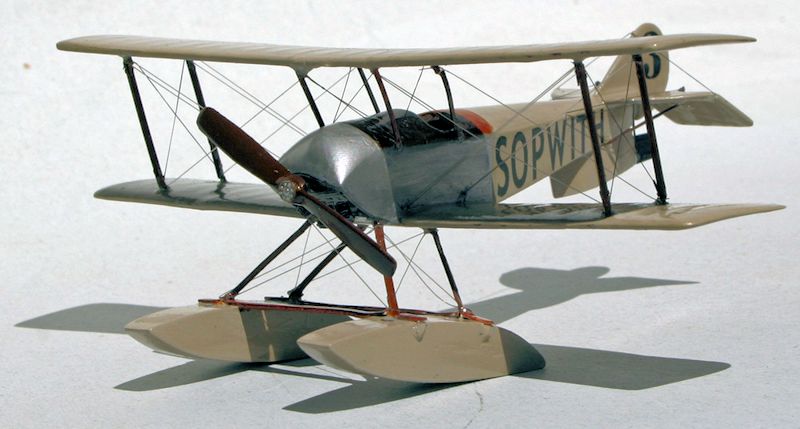
Eduard 1/72 Sopwith HS
| KIT #: | 7201 |
| PRICE: | $10 at a swap meet |
| DECALS: | |
| REVIEWER: | Peter Burstow |
| NOTES: | Simple conversion |

| HISTORY |
Designed by Harry Hawker and Fred Sigrist, the Sopwith SS, nicknamed “Tabloid”,
first flew on 27th November 1913, as a side-by-side two seat sporting aircraft.
Powered by an 80 h.p. Gnome rotary engine, it's performance was so good that a
single seat version was ordered for the R.F.C. and the R.N.A.S. It was one of
the very first mass produced military aircraft.
In February 1914, T. O. M. Sopwith started planning a float-plane version to
compete in the upcoming Coupe d'Aviation Maritime Jacques Schneider, later known
as the Schneider Trophy race, to be held at Monaco on 20th April that year.
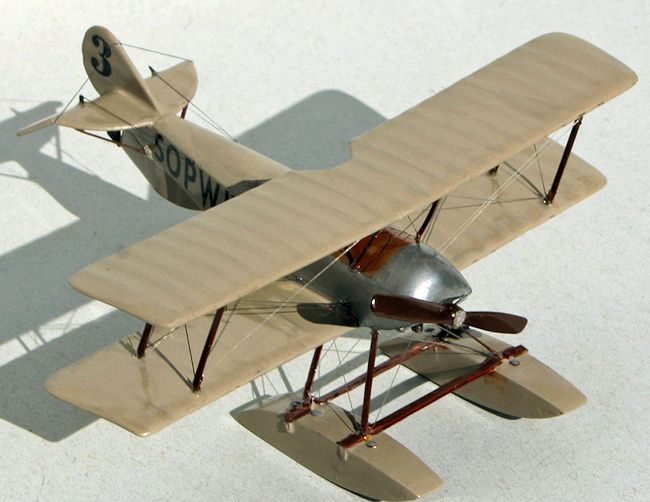 Fred
Sigrist made only minor changes to the SS, adding a small triangular fin and
enlarging the rudder. A 100 h.p. 9 cylinder Gnome Monosoupape (one valve per
cylinder) engine was fitted, the first such engine imported into Britain.
Floatation gear was designed by Sidney Burgoyne, a large central float was
added, with small floats under the wings, and a tail float.
Fred
Sigrist made only minor changes to the SS, adding a small triangular fin and
enlarging the rudder. A 100 h.p. 9 cylinder Gnome Monosoupape (one valve per
cylinder) engine was fitted, the first such engine imported into Britain.
Floatation gear was designed by Sidney Burgoyne, a large central float was
added, with small floats under the wings, and a tail float.
The aircraft, called the Sopwith HS, was completed on 31 March 1914, and
transported to the Hamble river near Southampton. Harry Hawker, Sopwith's usual
test pilot, was in Australia trying to sell more Tabloids, so Howard Pixton, who
had joined the company a few weeks before, attempted the first flight on the
evening of April 1st. On opening the throttle, the HS nosed in and tipped onto
it's back, dumping Howard into the river. After waiting for the tide, the
aircraft was recovered at 2 o'clock the next morning and returned to the factory
for repair
Running out of time, Sigrist and Burgoyne redesigned the float system for twin
floats. The large float was sawn in two, and sealed, the wing floats were
removed. A simple strut arrangement was used to support the floats. Early in the
morning of the 7th of April, the aircraft was taken to the Thames, where brief
flotation tests were done. Flying as prevented by Thames Conservancy river
wardens, an early attack by greenies. The next morning the aircraft was taken
further down river, outside the Thames Conservancy area, and a brief test flight
was completed, the only problem being a misfiring engine. The aircraft was then
returned to the factory, dismantled and packed for shipping to Monaco.
The Sopwith team arrived at Monaco on the 15th of April, the aircraft was
released by customs the next day and quickly assembled. The Gnome engine was
rusted from it's swim a few weeks before, and needed a thorough overhaul. The
aircraft was ready to fly on the 18th, but rough weather led to a postponement
until the 19th, the day before the race.
After the test flight the propeller was changed, and an extra six gallon fuel
tank was fitted. Some of the chassis rigging wire was replaced, as it had
stretched. This is very obvious in one of the photos of the HS on the beach at
Monaco, the float rigging wires are very slack.
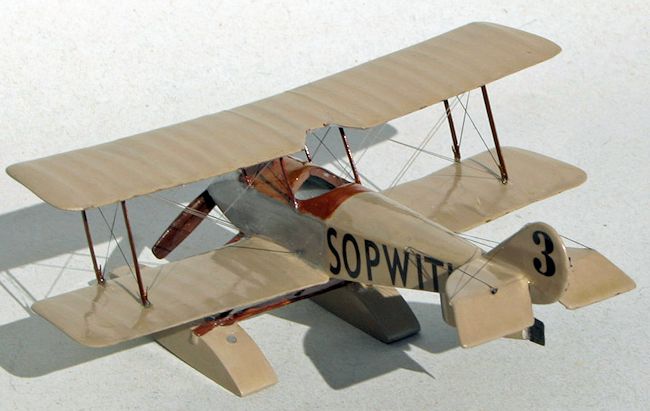 The
race, really a time trial, was held over a 10km triangular course, 28 laps being
required. The first competitors started just after the gun at 8am. Pixton
started at about quarter past the hour. The Sopwith HS had no problems
completing the course, other than the engine starting to misfire on the 15th
lap, so was running on 8 cylinders for almost half the way. Pixton completed the
course in a 2 hours and 39 seconds, with an average speed of 139.6 kph, (86.78
mph) which included two compulsory downwind touchdowns. He then did another two
laps of the course, setting a float-plane speed record over a 300km distance.
The
race, really a time trial, was held over a 10km triangular course, 28 laps being
required. The first competitors started just after the gun at 8am. Pixton
started at about quarter past the hour. The Sopwith HS had no problems
completing the course, other than the engine starting to misfire on the 15th
lap, so was running on 8 cylinders for almost half the way. Pixton completed the
course in a 2 hours and 39 seconds, with an average speed of 139.6 kph, (86.78
mph) which included two compulsory downwind touchdowns. He then did another two
laps of the course, setting a float-plane speed record over a 300km distance.
Of the other competitors, Lord Carberry, flying a Deperdussin, only completed a
single lap. Gabriel Espanet in a Nieuport dropped out after 17, and Adrien
Levasseur, also flying a Nieuport finished on lap 18. The only other competitor
to finish was the Swiss Ernest Burri, flying a Franco-British Aviation Co. FBA
type A flying boat. He took an hour and 23 minutes longer than the Sopwith to
complete the course, stopping for fuel on lap 24 didn't help.
The result was a emphatic win for the Sopwith HS floatplane. When Jacques
Schneider congratulated Howard Pixton, he offered a glass of champagne, Pixton
declined, saying he would prefer a Bass (beer).
Sopwith went on to build 160 “Schneider” float-planes, based on the HS, for the
R.N.A.S., some of which were still serving in 1918.
A Sopwith Schneider, re-engined with a 450h.p. Cosmos Jupiter radial, was
entered in the 1919 Schneider Trophy race. Conditions were so bad, with thick
fog, that Harry Hawker did not start the race.
| THE KIT |
Released by Eduard, kit 7201 represents the military version of the “Tabloid”
float-plane, known unofficially as the Sopwith Schneider. Judging by the kit
number, this might be the first 1/72 kit Eduard produced.
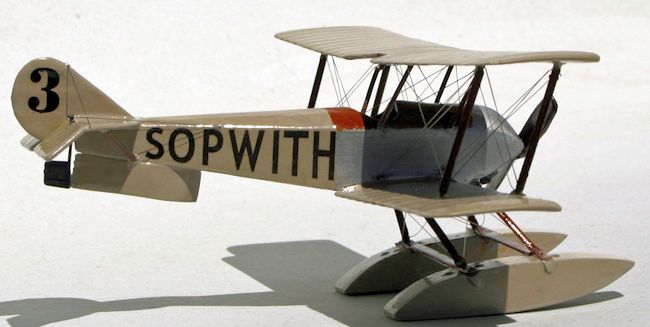 There is
a single moulded sprue in soft grey plastic, with 20 parts, crudely moulded with
large gates, lots of flash and stray lumps and bumps. An alternate fin and
rudder part is supplied to allow a late built “Schneider”. There is a very
exaggerated hills and valleys fabric effect on the wings, but little other
detail.
There is
a single moulded sprue in soft grey plastic, with 20 parts, crudely moulded with
large gates, lots of flash and stray lumps and bumps. An alternate fin and
rudder part is supplied to allow a late built “Schneider”. There is a very
exaggerated hills and valleys fabric effect on the wings, but little other
detail.
Somewhat making up for the horrible plastic parts, there are three frets of
etched brass, with detailing parts for the cockpit, engine, and various other
bits. One fret has all the struts. A small film sheet has an instrument panel,
which is to be laminated to the brass part.
The decal sheet, printed by Propagteam, has 14 roundels in different sizes and
styles, two different fin flashes and four sets of serials. The decals are
bright and in good registration, though the colours seem a little transparent. I
didn't use them, so cannot comment on their effectiveness.
Some minor changes are needed to convert the model into a HS. Fill the aileron
gaps and gun port on the wings, change the shape and mounting of the tail-float,
alter the float struts, and make new markings.
| CONSTRUCTION |
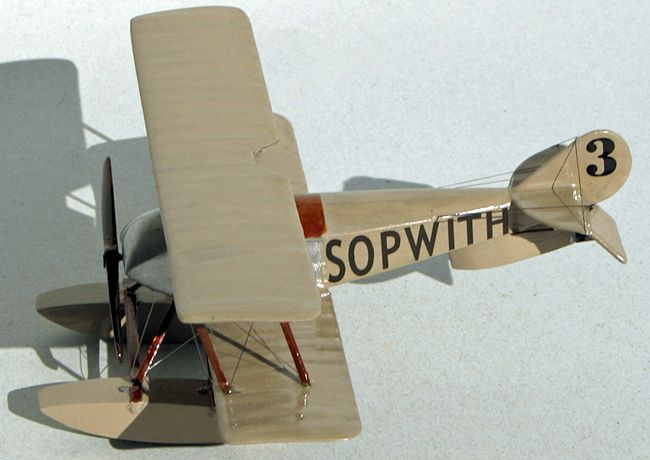 Next
step was the engine, the plastic lump needed a lot of clean up before it was
usable, then I added two brass bosses, and 9 of the 18 supplied tiny brass
push-rods. Only one per cylinder, as the engine is a Monosoupape. The
instructions got this a bit wrong. Some painting and dry brushing with Mr Metal
Color, Aluminium and Iron, brought out the detail, most of which is completely
hidden by the unusual bull-nosed cowling, which has a badly fitting brass plate
on it's underside.
Next
step was the engine, the plastic lump needed a lot of clean up before it was
usable, then I added two brass bosses, and 9 of the 18 supplied tiny brass
push-rods. Only one per cylinder, as the engine is a Monosoupape. The
instructions got this a bit wrong. Some painting and dry brushing with Mr Metal
Color, Aluminium and Iron, brought out the detail, most of which is completely
hidden by the unusual bull-nosed cowling, which has a badly fitting brass plate
on it's underside.
The wings needed a bit of work. First filling the engraved ailerons, the
Tabloids and early Schneiders were wing warpers, and didn't have any ailerons.
The instructions suggest binding the gaps for an early version. I filled the gun
port in the upper wing with a small piece of card, and more putty. The wings
then got a good sand to reduce the 'hills and valleys'. The wings probably only
looked that saggy when the plane was recovered from the Hamble. The lower wing
was a poor fit to the fuselage, needed a bit of hack and slash to get it to fit,
and a lot of filling to cover the resulting gaps.
I removed the elevator from the tailplane, and re-attached it hanging down. The
pictures of the HS when not flying, show the elevator drooping. The tailplane
and early version fin was then attached to the fuselage, with a bit more filling
needed.
I assembled the main and tail float halves, the fit on the main floats was not
good, with a large hollow needing filling along one of the joints. The tail
float was very much the wrong shape, photos and plans of the HS show the float
is tear-drop shaped in plan, and rectangular in elevation. A lot of sanding, and
some card and filler, fixed that. The tail float was then attached directly to
the fuselage.
| COLORS & MARKINGS |
| FINAL CONSTRUCTION |
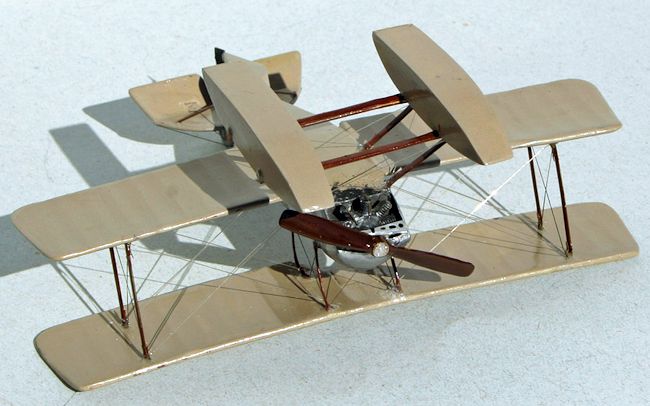 Drilled
out holes for the brass struts, there were only tiny dimples moulded into the
wing surface. Bent and added the inter-plane struts, then the upper wing. While
it was flexible, I aligned it with the plans to get the gap and stagger right.
The cabane struts were too short, by about 4mm, so were replaced with thin
plastic strip.
Drilled
out holes for the brass struts, there were only tiny dimples moulded into the
wing surface. Bent and added the inter-plane struts, then the upper wing. While
it was flexible, I aligned it with the plans to get the gap and stagger right.
The cabane struts were too short, by about 4mm, so were replaced with thin
plastic strip.
Assembled the main float structure, again using the etched brass struts
provided. The kit supplied 'N' struts for the main legs, correct for a
Schneider, but not for the HS, so the diagonal leg was cut away. The slots in
the main floats were then filled and smoothed over, hiding the joint. The float
assembly was joined to the fuselage and aligned while still flexible.
Just about to start rigging, when I noticed that the HS, unlike the later
Schneiders, had the float cross struts proud of the float, not recessed. Looks
just like a plank laid across the top. Chipped off the paint and superglue, then
fitted an Evergreen strip that looked about the right size.
The brass struts looked very two-dimensional so I ran a bead of medium thickness
slow superglue down both sides of each strut. Surface tension was enough to pull
the bead into a reasonable shape, thin along the edges and thicker down the
middle. Painted the struts Tamiya XF-68 NATO brown, then gave them a coat of
X-26 clear orange.
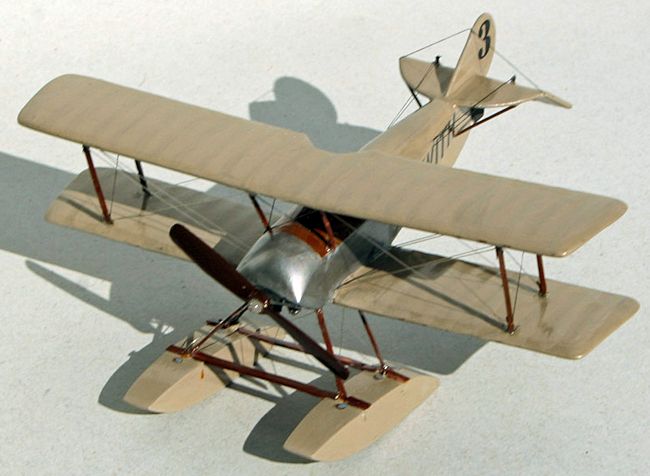 The
prop, with a tiny brass boss, was painted XF-9 hull red, then over-coated with
X-24 clear yellow, just to make it slightly different to the struts. I used some
rod to attach the prop to the engine, nothing was supplied with the kit. Photos
show the prop to be well forward of the cowling, a bit of trial fitting was
needed to get it looking right.
The
prop, with a tiny brass boss, was painted XF-9 hull red, then over-coated with
X-24 clear yellow, just to make it slightly different to the struts. I used some
rod to attach the prop to the engine, nothing was supplied with the kit. Photos
show the prop to be well forward of the cowling, a bit of trial fitting was
needed to get it looking right.
The HS had simple markings, A Sopwith logo on the fuselage sides, and the race
number, 3, on the tail. Using the draw program that came with Open Office, I
picked similar fonts and drew up the markings. After the usual trial and error,
I got the size about right, and laser printed the markings onto Microscale clear
trim film. As the markings were black text, not pictures, there was no problems
with pixelation.
I gave the model an overall coat of floor polish to help the decals. It looked
much better slightly gloss, so I gave it another coat over the decals.
I intended the model to represent the Sopwith HS on the 20th April 1914,
the day of the race. As it had only been assembled a few days before, and flown
once, I did not do any weathering, other than some oil staining under the cowl.
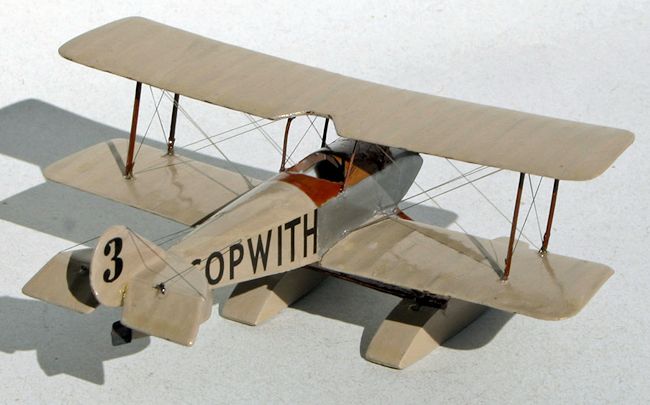
A number of brass control horns were supplied, and added as required.
A long and tedious job, about 30 rigging wires at about 15 minutes each,
and another couple of hours for the control wires. I can only do it in short
shifts, looking at and handling invisible threads, through an Optivisor makes me
cross-eyed.
The rigging adds a lot of strength and rigidity to a biplane model, and is well
worth the effort.
| CONCLUSIONS |
A modest conversion to produce an interesting aircraft, the first British
Schneider Trophy winner.
| REFERENCES |
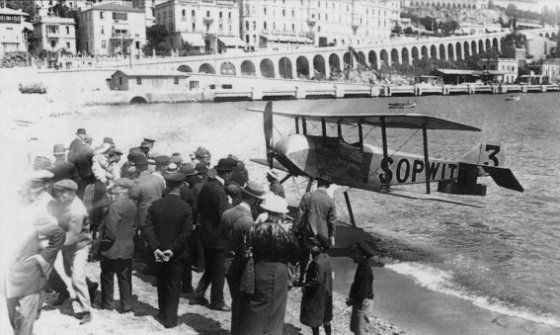 Fortunately,
a number of high quality photographs of the HS were taken at Monaco, flying, on
the water and the beach. These photos formed the best reference for the model.
Fortunately,
a number of high quality photographs of the HS were taken at Monaco, flying, on
the water and the beach. These photos formed the best reference for the model.
C. G. Grey, Sea-Flyers, Faber and Faber, London, 1942
Owen Thetford, British Naval Aircraft since 1912, Putnam, London, 1958.
Malcolm Hall, Sopwith Aviation Company, History Press, Stroud, 2011
Ralph Pegram, Schneider Trophy Seaplanes and Flying boats, Fonthill, England,
2012
http://en.wikipedia.org/wiki/Sopwith_Tabloid
http://en.wikipedia.org/wiki/Gnome_Monosoupape
December 2014
If you would like your product reviewed fairly and fairly quickly, please contact the editor or see other details in the Note to Contributors.